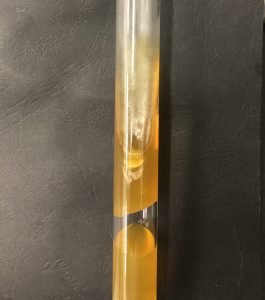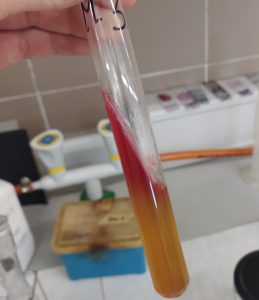Acidification of carbohydrates
Overview
The capacity of the bacteria to use carbohydrates by producing acid or acid and gas is determined.
This involves using the culture medium with Kliger Iron (Kliger Iron Agar or KIA), in which the production of hydrogen sulfide is also observed.
This culture medium contains lactose and glucose such as fermentable carbohydrates. Sodium thiosulfate as a substrate needed for the production of hydrogen sulfide, iron citrate and ammonium as a source of ions of Fe+3, which are combined with the hydrogen sulfide and they produce black iron sulfide. It also contains phenol red as a pH indicator.
Carrying out the practical
The bacteria to be tested is inoculated using the inoculation loop, starting with a prick from the center of the slanted surface (slant) towards the bottom of the test tube; when going back a streak is made on the surface of the slant.
It is incubated for 24 hours at 37ºC. After this time a yellow color that appears on the surface and on the bottom of the test tube is observed.
- a) The yellow color at the bottom points to the fact that the glucose has fermented. As well as this fermentation, gas might have been produced (gaseous metabolites) that becomes apparent with bubbles or ruptures at the bottom of the agar.
- b) The yellow color in the slant or slanted surface of the culture medium shows the degradation of lactose through which acidity is produced.
According to this, different results can be found, which are observed in the figures.





